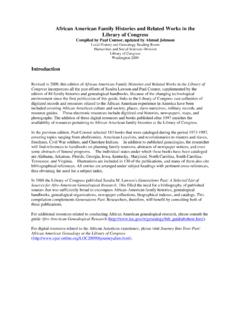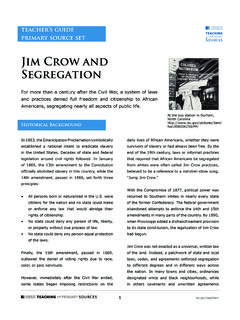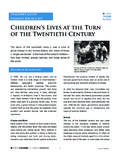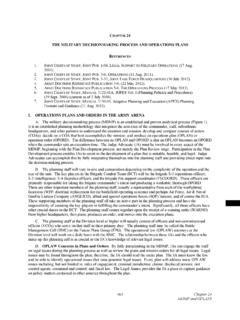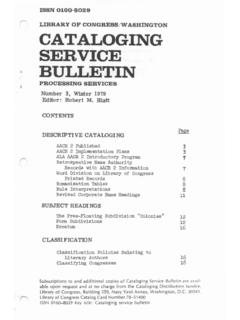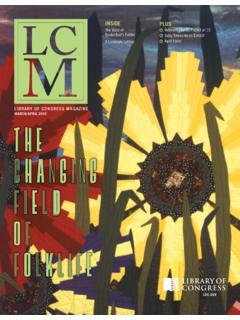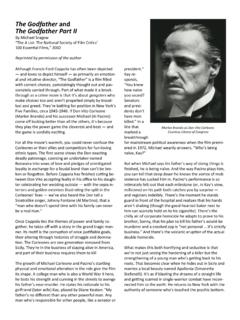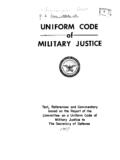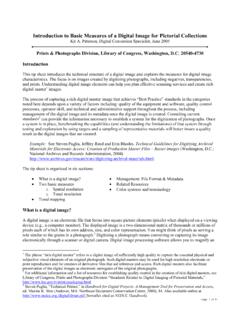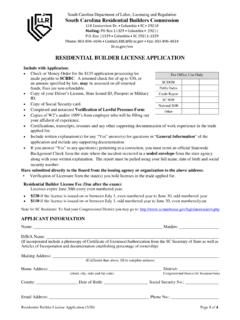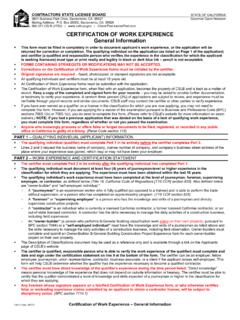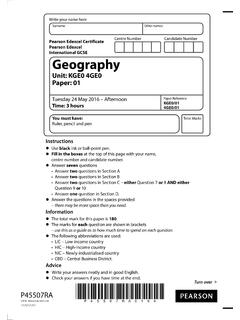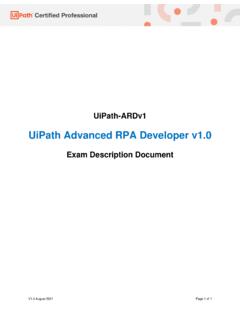Transcription of Nanook of the North - Library of Congress
1 Nanook of the North By Patricia R. Zimmermann and Sean Zimmermann Auyash Robert Flaherty's Nanook of the North (1922). represents one of the most significant Ameri- can documentaries: it operates as a Rosetta stone for debates about documentary ethics, representation, ethnography, orientalism. Doc- umenting the Inuit of Ungava Peninsula in Eastern Canada, the film follows Nanook (Allakariallak) and his family over ice flows, tun- dra, and bays as they hunt for food, navigate kayaks, and push their dogsled over ice and snow. British producer John Grierson dispar- aged Flaherty's structure of man against nature as excessively Romantic. Robert Flaherty is considered one of the first American independent filmmakers. Anti- Hollywood in its rejection of narrative causality and artifice, Nanook evokes many documen- tary styles: reenactment, staging, observational mode, ethnography, exploration, poetic experi- mental film, participatory mode, fiction, portrait, travelogue, landscape, adventure film, nature film, hybrid forms combining fiction and docu- mentary.
2 A 79-minute silent film, Nanook con- stitutes one of the first feature-length documen- taries. Flaherty wrote the intertitles, merging An advertisement featured in the June 17, 1922 edition of Motion poetic language and description: the rasp and Picture News. Courtesy Library of Congress Prints & Photographs hiss of driving snow, the melancholy spirit of Online Collection. the North .. Robert Flaherty (1884-1951) was first and foremost building scenes for him. This collaborative style an explorer. Son of an engineer, he grew up in min- countered the Hollywood studio system. But his ing camps in northern Michigan and Canada, filmmaking also subjected his subjects danger. learning the arts of frontier survival. Hired by Flaherty was more interested in cinematography Canadian railroad builder William Mackenzie in 1910 than in editing sequences. to prospect the Hudson Bay area, Flaherty under- took four expeditions to map this unknown country to Pathe Frere, the French film distribution, released locate gypsum and lignite.
3 Between 1914 and 1915, Nanook in New York City on 11 June 1922. The film he shot film and photographs on two expeditions. In was a commercial success in the United States and 1916, while editing, his cigarette fell onto the out- internationally, earning worldwide gross receipts of takes. 30,000 feet of nitrate film exploded. In 1920, $251,000. The film inspired a Broadway song, after raising money from Revillion Freres, a French Nanook , whose orientalist lyrics explain: ever- fur company, to produce a second film, he returned loving Nanook , though you don't read a book, but to Hudson Bay. oh, how you can love.. Flaherty spent 16 months living with the Inuit. He Nanook of the North adopts a journey structure shot all the sequences but the Inuit collaborated in based on the seasons, from summer to winter. It em- determining scenes, repairing the camera (known as ploys an episodic structure, rather than linear cau- the aggie ), and developing the film.
4 He screened sality. The film features four action scenes demon- rushes for Inuit. They staged hunting and the igloo strating Nanook 's prowess securing food: fishing, and hunting walrus, fox, and seal. Scenes of the fam- Ruby contends a more holistic analysis of Flaherty's ily traveling over ice flows with kayaks and pulling work requires understanding the social structures dogsleds over snowy hills mark the difficulties of enabling the film's creation. Ruby seeks to contextu- movement through arctic landscapes. The center of alize rather than aestheticize the film in order to un- the film focuses on building an igloo out of snow, derstand interactions between Flaherty and the Inuit. condensing ideas about family, food, shelter, survival. He argues Flaherty worked in conjunction with the Inuit to create an images from their perspective. Channeling his experience as a photographer and adventurer, Nanook employs portrait photography In contrast, Tobing Rony positions Nanook of the interspersed with landscape tableaus.
5 These two ele- North within racialized, orientalist Western discours- ments combine, indicating Flaherty's technical mas- es present at the time of its production. Tobing Rony tery and complex visual aesthetic. Portrait and action argues that Nanook of the North perpetuates the shots comprise the film's visual structure. For exam- then present-day ideology of the Inuit as a cuddly ple, when Nanook juts his head out from his newly primitive people. For Tobing Rony, Flaherty did not constructed igloo, a door which he has just cut out want to show the Inuit as they were at the time of the frames his face as the snow white igloo fills the neg- film's creation, but as (he thought) they had been.. ative space. This shot contrasts with the opening She labels the mode of representation of the shot in the film where, in tracking shot, Flaherty re- ethnographic' which emerged from this impulse veals the expanse of sea and hills of the sparse taxidermy.
6 For her, taxidermy seeks to make that Ungava peninsula. Flaherty's juxtaposition of two dif- which is dead look as if it were still living. Within this ferent visual aesthetics creates a counterpoint of inti- framework, Tobing Rony focuses on the ways mate familial or action hunting scenes interspersed Flaherty rendered the Inuit to appear more primitive with landscape tableaus. and more violent. Tobing Rony argues Flaherty fit the Inuit within preexisting Western European assump- The film also points to Flaherty's knowledge of Inuit tions, rather than structuring Nanook of the North . artistic practices. He had collected their drawings to challenge those preconceptions. during his time in Canada. Many scenes emulate drawings and carvings done by Inuit artists. This The views expressed in this essay are those of the author and do not necessarily represent the views of the Library of Congress .
7 Style consists of small figures in action surrounded by large amounts of white, negative space. Flaherty uses the snowy landscape to create white negative space resonating with Inuit art forms. For example, during their trek to the seal hunting grounds, Patricia R. Zimmermann is Professor of Screen Studies Nanook 's family enters the shot one at a time, walk- and Codirector of the Finger Lakes Environmental Film ing across a ridge until we see the whole party Festival at Ithaca College. Her books include Reel Fami- dwarfed by a white snowy background, evoking Inuit lies: A Social History of Amateur Film; States of Emergen- art visual structures. Flaherty's cinematography re- cy: Documentaries, Wars, Democracies; Mining the Home jects Western styles of cinematic depth and charac- Movie; and Thinking through Digital Media: Transnational ter centered compositional balance. Environments and Locative Places.
8 Many theoretical debates surround Nanook of the Sean Zimmermann Auyash has an MA Honours in Interna- North . The writings of Jay Ruby and Fatimah Tobing tional Relations from the University of St. Andrews in Rony condense arguments swirling around the film. Scotland. He interned for the Brent Scowcroft Center on International Security at the Atlantic Council, for Repre- Ruby contextualizes Nanook of the North as a col- sentative Carolyn McCarthy (NY, 4th district), and for the laboration. He argues the film cannot be removed Institute of International and Social Studies, Tallinn from the conditions of its production, the culture, ide- University, Estonia. He was a marketing researcher for ology and intentions of the producer and the contexts Outcast Films and BoomGen Studio, doing outreach in which it is displayed. Ruby argues against schol- for The Square (2013) a documentary chronicling the ars who focus purely on analysis of the film's images.
9 Tahrir Square revolution.
